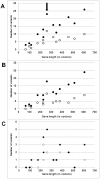Phylogeny and patterns of diversity of goat mtDNA haplogroup A revealed by resequencing complete mitogenomes
- PMID: 24763315
- PMCID: PMC3999278
- DOI: 10.1371/journal.pone.0095969
Phylogeny and patterns of diversity of goat mtDNA haplogroup A revealed by resequencing complete mitogenomes
Abstract
We sequenced to near completion the entire mtDNA of 28 Sardinian goats, selected to represent the widest possible diversity of the most widespread mitochondrial evolutionary lineage, haplogroup (Hg) A. These specimens were reporters of the diversity in the island but also elsewhere, as inferred from their affiliation to each of 11 clades defined by D-loop variation. Two reference sequences completed the dataset. Overall, 206 variations were found in the full set of 30 sequences, of which 23 were protein-coding non-synonymous single nucleotide substitutions. Many polymorphic sites within Hg A were informative for the reconstruction of its internal phylogeny. Bayesian and network clustering revealed a general similarity over the entire molecule of sequences previously assigned to the same D-loop clade, indicating evolutionarily meaningful lineages. Two major sister groupings emerged within Hg A, which parallel distinct geographical distributions of D-loop clades in extant stocks. The pattern of variation in protein-coding genes revealed an overwhelming role of purifying selection, with the quota of surviving variants approaching neutrality. However, a simple model of relaxation of selection for the bulk of variants here reported should be rejected. Non-synonymous diversity of Hg's A, B and C denoted that a proportion of variants not greater than that allowed in the wild was given the opportunity to spread into domesticated stocks. Our results also confirmed that a remarkable proportion of pre-existing Hg A diversity became incorporated into domestic stocks. Our results confirm clade A11 as a well differentiated and ancient lineage peculiar of Sardinia.
Conflict of interest statement
Figures


Similar articles
-
Whole mitochondrial genomes unveil the impact of domestication on goat matrilineal variability.BMC Genomics. 2015 Dec 29;16:1115. doi: 10.1186/s12864-015-2342-2. BMC Genomics. 2015. PMID: 26714643 Free PMC article.
-
Haplotype affinities resolve a major component of goat (Capra hircus) MtDNA D-loop diversity and reveal specific features of the Sardinian stock.PLoS One. 2012;7(2):e30785. doi: 10.1371/journal.pone.0030785. Epub 2012 Feb 17. PLoS One. 2012. PMID: 22363488 Free PMC article.
-
Investigation of the diversity and origins of Chinese dairy goats via the mitochondrial DNA D-loop.J Anim Sci. 2015 Mar;93(3):949-55. doi: 10.2527/jas.2014-8420. J Anim Sci. 2015. PMID: 26020873
-
The genetic diversity of mtDNA D-loop and the origin of Chinese goats.Yi Chuan Xue Bao. 2006 May;33(5):420-8. doi: 10.1016/S0379-4172(06)60069-3. Yi Chuan Xue Bao. 2006. PMID: 16722337
-
Genetic diversity and molecular phylogeography of Chinese domestic goats by large-scale mitochondrial DNA analysis.Mol Biol Rep. 2014 Jun;41(6):3695-704. doi: 10.1007/s11033-014-3234-2. Epub 2014 Feb 17. Mol Biol Rep. 2014. PMID: 24532161
Cited by
-
Assessing the Diversity and Population Substructure of Sarda Breed Bucks by Using Mtdna and Y-Chromosome Markers.Animals (Basel). 2020 Nov 24;10(12):2194. doi: 10.3390/ani10122194. Animals (Basel). 2020. PMID: 33255190 Free PMC article.
-
Mitochondrial DNA variation reveals maternal origins and demographic dynamics of Ethiopian indigenous goats.Ecol Evol. 2018 Jan 3;8(3):1543-1553. doi: 10.1002/ece3.3710. eCollection 2018 Feb. Ecol Evol. 2018. PMID: 29435231 Free PMC article.
-
Whole mitochondrial genomes unveil the impact of domestication on goat matrilineal variability.BMC Genomics. 2015 Dec 29;16:1115. doi: 10.1186/s12864-015-2342-2. BMC Genomics. 2015. PMID: 26714643 Free PMC article.
-
Ecogroups and maternal haplogroups reveal the ancestral origin of native Chinese goat populations based on the variation of mtDNA D-loop sequences.Ecol Evol. 2023 Aug 7;13(8):e10382. doi: 10.1002/ece3.10382. eCollection 2023 Aug. Ecol Evol. 2023. PMID: 37554396 Free PMC article.
-
Maternal Origins and Haplotype Diversity of Seven Russian Goat Populations Based on the D-loop Sequence Variability.Animals (Basel). 2020 Sep 9;10(9):1603. doi: 10.3390/ani10091603. Animals (Basel). 2020. PMID: 32916903 Free PMC article.
References
-
- Clutton-Brock J (1999) A natural history of domesticated mammals. 2nd ed. Cambridge (UK) :Cambridge University Press.
-
- Diamond J (2002) Evolution, consequences and future of plant and animal domestication. Nature 418: 700–707. - PubMed
Publication types
MeSH terms
Substances
LinkOut - more resources
Full Text Sources
Other Literature Sources

